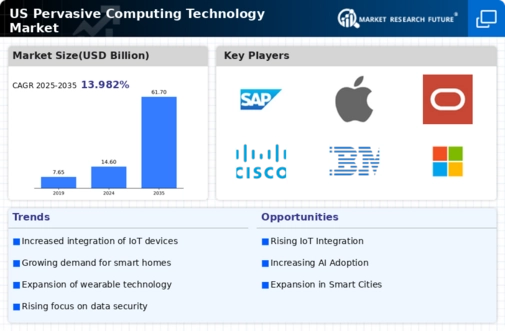Growing Focus on Edge Computing
The shift towards edge computing is emerging as a significant driver for the pervasive computing-technology market. By processing data closer to the source, edge computing reduces latency and bandwidth usage, which is particularly beneficial for applications requiring real-time data analysis. As of 2025, the edge computing market is anticipated to reach $15 billion in the US, reflecting a growing recognition of its advantages. This trend is particularly relevant for industries such as manufacturing, healthcare, and transportation, where timely data processing is crucial. The integration of edge computing with pervasive technologies enhances operational efficiency and supports the development of intelligent systems that can respond dynamically to changing conditions, thereby fostering innovation within the pervasive computing-technology market.
Rising Demand for Smart Devices
The pervasive computing-technology market experiences a notable surge in demand for smart devices, driven by consumer preferences for convenience and connectivity. As of 2025, the market for smart home devices alone is projected to reach approximately $100 billion in the US. This trend indicates a growing inclination towards integrating technology into daily life, enhancing user experiences through automation and remote control. The proliferation of smart devices, including wearables, smart appliances, and IoT-enabled gadgets, contributes to the expansion of the pervasive computing-technology market. Furthermore, the increasing adoption of smart devices in various sectors, such as healthcare and automotive, suggests a robust growth trajectory, as these technologies facilitate real-time data collection and analysis, ultimately improving efficiency and decision-making processes.
Emerging Applications in Healthcare
The healthcare sector is increasingly adopting pervasive computing technologies, which serves as a significant driver for the market. The integration of wearable devices, telemedicine, and remote monitoring systems is transforming patient care and management. As of 2025, the market for wearable health technology is projected to exceed $30 billion in the US, indicating a strong demand for innovative healthcare solutions. These technologies enable continuous health monitoring, data collection, and real-time feedback, which can lead to improved patient outcomes and reduced healthcare costs. The ongoing emphasis on personalized medicine and preventive care further underscores the potential of pervasive computing in healthcare, suggesting that this sector will continue to be a key growth area for the pervasive computing-technology market.
Advancements in Network Infrastructure
The evolution of network infrastructure plays a critical role in shaping the pervasive computing-technology market. With the rollout of 5G technology, the US is witnessing enhanced connectivity and reduced latency, which are essential for the seamless operation of pervasive computing applications. The 5G network is expected to support a vast number of connected devices, potentially exceeding 1 million devices per square kilometer. This advancement not only facilitates faster data transmission but also enables the development of innovative applications in sectors such as smart cities, healthcare, and transportation. As organizations invest in upgrading their network capabilities, the pervasive computing-technology market is likely to benefit from increased adoption rates and the emergence of new use cases that leverage high-speed connectivity.
Increased Investment in Smart Infrastructure
Investment in smart infrastructure is a pivotal factor driving the pervasive computing-technology market. As cities across the US strive to enhance urban living through technology, the demand for smart infrastructure solutions is on the rise. This includes smart grids, intelligent transportation systems, and connected public services, which collectively aim to improve efficiency and sustainability. The US government has allocated substantial funding for smart city initiatives, with estimates suggesting an investment of over $50 billion by 2025. Such investments not only facilitate the deployment of pervasive computing technologies but also encourage public-private partnerships that can accelerate innovation and implementation. Consequently, the pervasive computing-technology market is likely to witness robust growth as these initiatives materialize.

















Leave a Comment